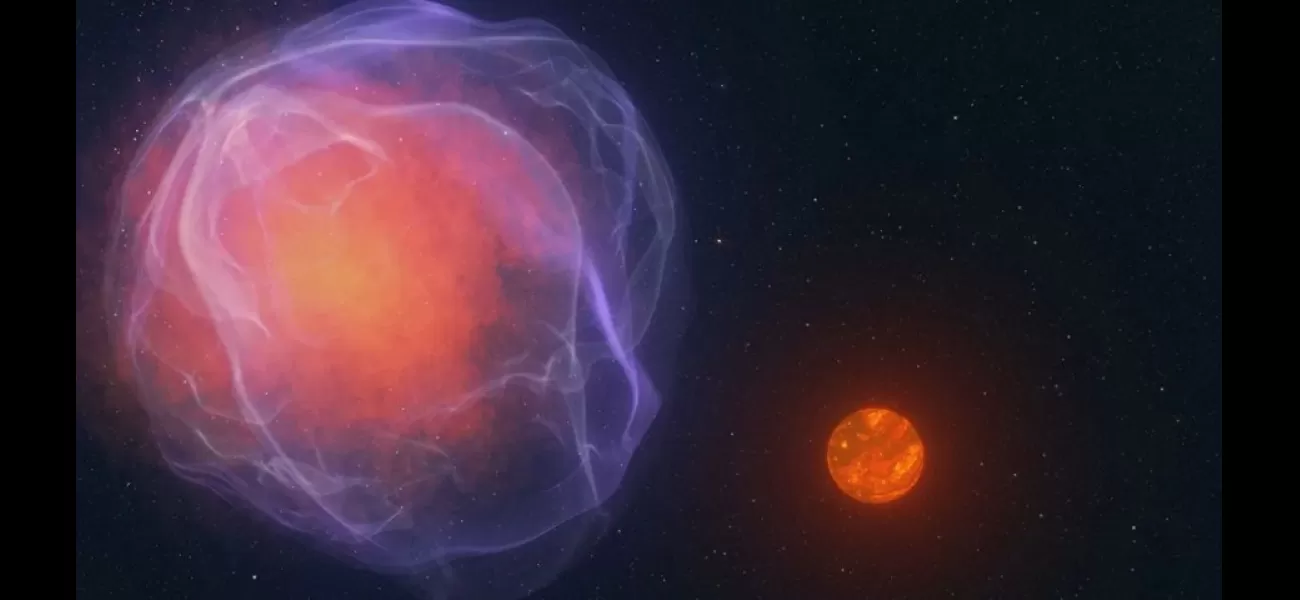A strange "failed star" has been observed zooming through the universe at a speed of more than 1 million miles per hour.
A massive unknown object is more than 27,000 times larger than our planet.
August 20th 2024.

A massive object has been detected soaring through the vastness of space, whizzing past galaxies and hurtling towards the unknown. This celestial body, estimated to be over 27,000 times larger than our own planet, is moving at mind-blowing speeds that could potentially launch it out of our very own Milky Way and into the depths of intergalactic space.
Scientists are still trying to decipher the exact nature of this rogue object, but initial speculations suggest that it may be a "brown dwarf," a type of star that is bigger than a planet but lacks the ability to sustain nuclear fusion like our sun. With a mass approximately 80 times that of Jupiter, it falls right on the cusp between being a star and a brown dwarf, often referred to as a "failed star."
The discovery of this enigmatic object was made possible by a group of citizen-scientists working alongside NASA's "Backyard Worlds: Planet 9" project. One such citizen-scientist, Martin Kabatnik from Germany, expressed his excitement upon spotting the object, saying, "I can't even put into words how thrilled I was. When I saw how fast it was moving, I was convinced that it must have already been reported."
While the cause of this object's incredible speed remains a mystery, scientists have put forth a few theories. One suggests that it may have been propelled out of its solar system by the explosive death of a nearby "white dwarf" star, resulting in a supernova. Another possibility is that it was flung away from its original orbit by a black hole, gaining enough momentum to break free and soar into the depths of space.
After being flagged by the citizen-scientists, a team of astronomers used the Keck I Telescope, located on the dormant volcano Maunakea in Hawai'i, to follow up on the discovery. Team leader Adam Burgasser shared their findings, saying, "We were able to identify a very low-mass object, right on the boundary between a star and a brown dwarf, with an extremely high velocity. In fact, it may be moving so fast that it is no longer bound to our Milky Way galaxy."
This newfound object, nicknamed CWISE J1249, adds to the growing list of "hypervelocity" stars that have been spotted in the past few decades. What makes this discovery even more intriguing is its relatively close proximity to us, only 400 light-years away. Burgasser also noted that this finding presents a unique opportunity to study brown dwarfs in distant regions of our galaxy, such as the center, halo, and various globular clusters and satellites.
In a nutshell, this rogue object has opened up a whole new avenue for scientists to delve into the mysteries of brown dwarfs, and with its incredible speed, it may hold the key to unlocking secrets of the farthest corners of the Milky Way. Who knows what other wonders await us as we continue to explore the vastness of space.
Scientists are still trying to decipher the exact nature of this rogue object, but initial speculations suggest that it may be a "brown dwarf," a type of star that is bigger than a planet but lacks the ability to sustain nuclear fusion like our sun. With a mass approximately 80 times that of Jupiter, it falls right on the cusp between being a star and a brown dwarf, often referred to as a "failed star."
The discovery of this enigmatic object was made possible by a group of citizen-scientists working alongside NASA's "Backyard Worlds: Planet 9" project. One such citizen-scientist, Martin Kabatnik from Germany, expressed his excitement upon spotting the object, saying, "I can't even put into words how thrilled I was. When I saw how fast it was moving, I was convinced that it must have already been reported."
While the cause of this object's incredible speed remains a mystery, scientists have put forth a few theories. One suggests that it may have been propelled out of its solar system by the explosive death of a nearby "white dwarf" star, resulting in a supernova. Another possibility is that it was flung away from its original orbit by a black hole, gaining enough momentum to break free and soar into the depths of space.
After being flagged by the citizen-scientists, a team of astronomers used the Keck I Telescope, located on the dormant volcano Maunakea in Hawai'i, to follow up on the discovery. Team leader Adam Burgasser shared their findings, saying, "We were able to identify a very low-mass object, right on the boundary between a star and a brown dwarf, with an extremely high velocity. In fact, it may be moving so fast that it is no longer bound to our Milky Way galaxy."
This newfound object, nicknamed CWISE J1249, adds to the growing list of "hypervelocity" stars that have been spotted in the past few decades. What makes this discovery even more intriguing is its relatively close proximity to us, only 400 light-years away. Burgasser also noted that this finding presents a unique opportunity to study brown dwarfs in distant regions of our galaxy, such as the center, halo, and various globular clusters and satellites.
In a nutshell, this rogue object has opened up a whole new avenue for scientists to delve into the mysteries of brown dwarfs, and with its incredible speed, it may hold the key to unlocking secrets of the farthest corners of the Milky Way. Who knows what other wonders await us as we continue to explore the vastness of space.
[This article has been trending online recently and has been generated with AI. Your feed is customized.]
[Generative AI is experimental.]
0
0
Submit Comment





